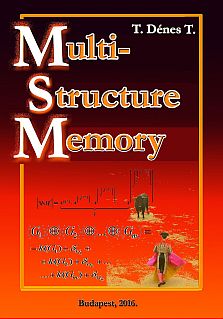C
o n t e n t s
FOREWORD
....1.
On the idea of System and Phenomenon
..... ... (From the philosophical abstraction
to reality of information)
1.1. Interpretation of the System
1.1.1. Constellation and impressionism (thinking experiment)
1.2. Philosophical level demonstration model
1.3. Bridge between the philosophical and the information level
1.4. Condition and Function of System
1.5. Theorem of Structure«-»Function interaction
... 2.
INFORMATION-»
COGNITION-»
KNOWLEDGE
........ (The laws
of Phenomenon and Cognition)
2.1. The concept of cognition and its relationship to the reference
aspects
2.2. Foundations of phenomenon description
2.3. Value of the reference aspects and measure of the phenomenon
description
2.4. The special's and exception's laws of the cognition
process
...
2.5. The phenomenon of cumulativities
2.5.1. The mathematical description of cumulativities
2.5.2. Analisys of the cognition proces's structure
2.5.3. The ideal cognition process and the efficiency index
2.6. The cognition proces's "Periodic table" (CPT)
2.6.1. The learning typing in CPT (thinking
episode)
2.6.2. The problem solving's "Periodic table" (PPT)
2.6.3. The phenomenon of creativity and intuition in
PPT (thinking
episode)
2.7. The equivalence of truth and convergence criteria in the
cognition
2.7.1. The convergence of the cumulativities and cognition
process
2.7.2. Analisys of the convergence and truth criteria at the finite
cognitive processes
2.7.3. Based on the cognitive development strategies by the strengthening
structures
2.7.4. Comments on the application
....3. GENERAL
LAWS of the LIVING SYSTEMS
3.1. Mathematical model of the Multistructure Memory (MsM)
3.1.1. Structures
fit into MsM
3.2. The structural definition of development (the complexity
and stability of systems)
3.2.1. The phenomenon criteria of development
3.2.2. Structural complexity of systems
3.2.3. Structural stability of systems
3.2.4. The mathematical definition of development
3.3. SYSTEM«-»ELEMENT
transition (Living or Inorganic System?)
...... (The law of multistructuring)
3.3.1. The diversity of living systems (number of the k-level multistructures)
3.3.2. Specifics of the living and inorganic systems
3.3.3. The society as a synonym of the living system (thinking
episode)
3.4. The Structuredifference-effect (Sd-effect) as the
general law of systems
3.4.1. Structuredifference in MsM
3.4.2. Living and inorganic function
3.4.3. Sd-effect appearing in the genetic code, as the structural
explanation of 20 triplets instead of 64 (thinking
episode)
3.5. Structure-space and structure-energy
..... (Theorem of the structure-conservation
as the general theory of conservation laws)
3.5.1. The Sd-number as distance in the structure-space
3.5.1.1. Uniform reference system in MsM
3.5.1.2. The Universe as multistructure-space (thinking
episode)
3.5.2. The structure-energy (S-energy)
3.5.2.1. The growth of S-energy is limited at a given multistructure
level
3.5.2.2. Additive law of S-energy
3.5.3. The structure-mass (S-mass)
3.5.3.1. Classical concepts and paradoxes of mass
3.5.3.2. Equivalence theorem of S-energy=S-mass
3.5.3.4. Quantitative conversion law of S-mass-»S-energy
3.5.3.5. Structural generalization of the E=mc2 in MsM
3.5.4. The structure-force (S-force)
3.5.4.1. The specialty of interaction (thought provoking!)
3.5.4.2. The gravity as S-force field (thinking
episode)
3.5.4.2.1. Theoretical approaches of the classical gravity (in metric
space)
3.5.4.2.2. Unifying theories in the metric space
3.5.4.3. The precise definition in MsM of the problem of SINGLE
SPACE THEORY in metric space
3.5.5. Multistructure theory of the energy conservation
3.5.5.1. Bull ring model (thinking experiment at the energy
conservation)
3.5.5.2. Bull ring model in the MsM multistructure-space
3.5.5.3. "Perpetum mobile" as "outattached" energy
from MsM (thinking
episode)
3.5.6. Metric and structural "orderliness"
3.5.7. Structural balance in MsM
3.5.7.1. Self-complementary graph "thermostat" (thought
provoking!)
3.5.8. Convergence's law in the multistructure-space (The fundamentally
different nature of the set and structure model)
3.5.8.1. Epistemological conclusions
3.5.8.2. The world are working to MsM (Decline the human intellectual
and emotional abilities?)
3.6. The structure-time as system
attribution
3.6.1. Linear-time in the metric space
3.6.2. Structure-time (ST)
3.6.2.1. The Planck time, or to the four-dimensional space-time universe
corresponding MsM multistructure-space (thinking
episode)
3.6.2.2. The expanding universe as a special case of the multistructure-space
(thinking
episode)
3.6.3. Speed in the multistructure-space
3.6.3.1. Extreme value of the structure-speed in MsM
3.6.4. Momentum, work and efficiency in the MsM
3.6.5. Structure-time function
3.6.6. The Periodic Table of Structuring (PTS) (The "orderliness"
of structure-time)
3.6.7. Clocks in the multistructure-space
3.6.7.1. The linear clock
3.6.7.2. The structural clocks
3.6.7.2.1. The spider's clock is the cobweb
3.6.7.2.2. The intuitive clock
3.6.7.2.3. The mathematical description of intuition in MsM
3.6.7.2.4. An example of the application of intuition in problem solving
3.6.8. The time conservation's law
3.6.9. The law of slowing time (aging in developing systems)
3.6.10. Time Paradox (section of system-times)
3.6.11. Simultaneity and "twin paradox"
3.6.11.1. Simultaneity in the space-time
3.6.11.2. Simultaneity in MsM
3.6.12. Growth without development (Trap of the quantitative
system modeling)
3.6.12.1. Virtual Greyhound Racing effects, or the globalization in
MsM (thinking
episode)
3.7. The structural concept, definition and laws of evolution in MsM
3.7.1. The "secret forerunners" of the evolution's theory
3.7.2. The conceptual criteria of evolution (selection, mutation,
replication)
3.7.3. Structural definition of the evolution (Structural Periodic
Table of Evolution: SPE)
3.7.3.2. The reproduction's description in MsM
3.7.3.2.1. Cleavage
3.7.3.2.2. New multistructure level
3.7.4. The law of evolution in MsM
3.7.5. The world are working to MsM
..4.
MATHEMATICS of the MsM-graphs
4.1. The graph-term evolution
4.2. Operations with MsM-graphs
4.3. Fundamental definitions
4.4. Fundamental theorems
APPENDIX
A1. Mathematical basic definitions and theorems
A2. The system-hologram as MsM (The mathematical model of
system holography)
A3. The network theory embed to Multistructure Theory
A4. The multistructural model of chess game (Structural thinking
in chess)
Bibliography
Name index
Object index
